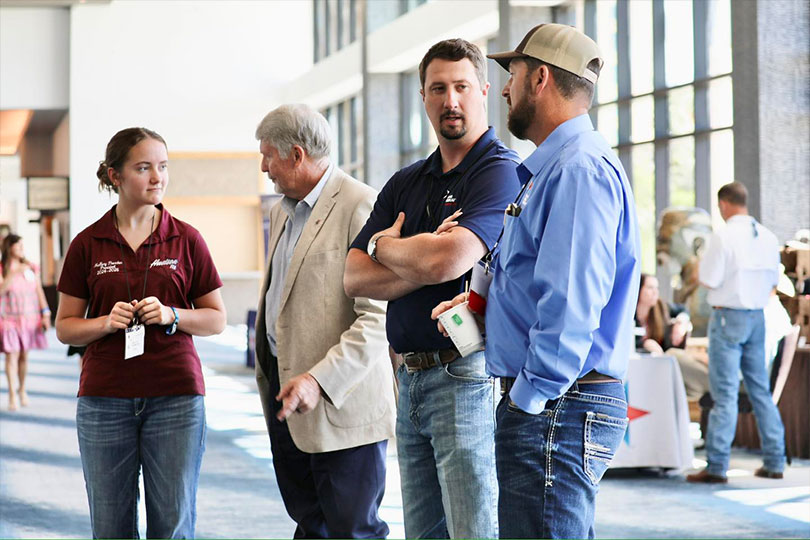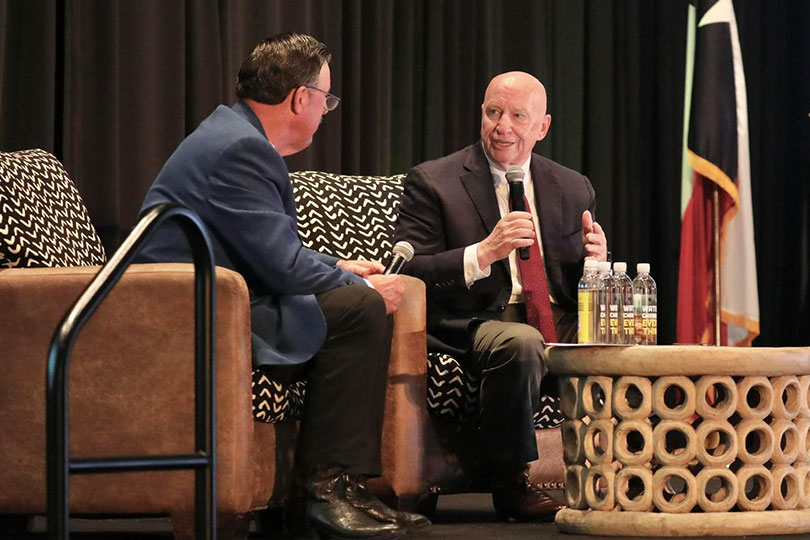By Julie Tomascik
Editor
Livestock issues, the farm bill, taxes and trade were among the topics highlighted during the Texas Farm Bureau Summer Conference.
More than 500 farmers and ranchers were in Round Rock June 16-18 for the meeting that gave an update on agricultural trends, issues and a state legislative recap.
“This conference gives our members the chance to get updates on important issues and hear directly from agricultural experts and economists,” TFB President Russell Boening said. “It’s also a valuable opportunity to ask questions and learn from one another as we navigate the challenges facing Texas agriculture.”
Livestock issues
After six years of cattle herd liquidation, signs of gradual rebuilding are beginning to emerge, though experts say numbers may not return to previous highs.
Despite tighter inventory, increased carcass weights and efficiency gains have kept production strong, according to Kevin Good, vice president of Industry Relations for CattleFax.
He noted beef-on-dairy crosses are rising, making up a growing share of feedyard placements. But with the southern border closed to live cattle imports due to the threat of the New World screwworm, U.S. feedyard placements continue to drop, tightening supplies even more. Each month the border remains closed, the U.S. feedyard system could see 100,000 fewer head.
Tighter supplies and inflation are driving up retail beef prices, but consumers still show a preference for beef with retail demand remaining steady.
“We still have a consumer that is willing to come to the table even with higher and higher prices over the last two years,” Good said. “But for how much longer?”
The global market will continue to play a crucial role in supporting U.S. cattle prices, Good said. Trade agreements and market access will continue to be factors that influence long-term demand for U.S. beef worldwide.
Texas Animal Health Commission representatives also provided an update on the New World screwworm, chronic wasting disease and the animal disease traceability program.
Taxes and trade
Former U.S. Rep. Kevin Brady, a key architect of the Tax Cuts and Jobs Act, discussed the importance of preserving tax reforms set to expire this year.
“Our tax code was outdated, and the 2017 reforms helped grow the economy,” Brady said. “It’s critical we not only extend those cuts but improve them. If we don’t, agriculture could face tax hikes and the return of the death tax.”
He described the current reconciliation effort as the “Super Bowl of tax,” with a goal of getting a package to the president’s desk by July 4.
Brady also highlighted trade, especially the upcoming U.S.-Mexico-Canada Agreement (USCMA) review and ongoing challenges with Mexico and Canada.
“Non-tariff barriers, dairy disputes, and lack of follow-through on ag technology and energy commitments—those are big issues,” he said. “Agriculture is always first to be targeted in a trade war. We need fair treatment and strong advocacy.”
He praised Farm Bureau’s grassroots efforts in building relationships with lawmakers and pushing for solutions on taxes and trade, as well as other issues related to agriculture.
Farm bill and farm economy
Farm income remains under pressure, especially for row crop farmers, due to falling commodity prices and high input costs.
“We’re looking at the third year in a row where the returns from raising a crop are less than the cost of production,” said Dr. John Newton, economist and executive head of Terrain.
The livestock sector, however, is seeing stronger returns. Cattle prices are at record highs, and dairy margins have improved. Reduced feed prices are helping offset production costs, especially in the dairy and beef sectors.
“It’s really a tale of two economies,” Newton said. “It’s pretty challenging on the crop side and favorable for many of the livestock producers.”
He discussed federal assistance distributed to agriculture. Since 2017, Congress has delivered over $136 billion in ad hoc aid, compared to about $20 billion from traditional farm bill programs like ARC and PLC.
That’s why a new farm bill is critical, Newton said.
Proposed changes to a new, modernized farm bill include raising reference prices and strengthening crop insurance. He said lawmakers aim to “put the farm back in the farm bill” by shifting more of the bill’s funding toward farm programs, increasing their share from 20% to about 30%.
Savings may come from tightening overpayment rates in the SNAP program, the farm bill’s largest expense.
Newton and fellow economist Dr. Bart Fischer, who is the co-director of the Texas A&M Agricultural & Food Policy Center, also pointed to trade and domestic demand as vital to farm recovery, citing several opportunities with other countries.
Estate planning
Dr. Jason Johnson, a Texas A&M AgriLife Extension economist and fifth-generation rancher, shared practical estate planning guidance from both his personal and professional backgrounds.
He stressed the importance of open communication with family members and making wishes clear in advance. Johnson encouraged attendees to prepare and organize legal documents now to prevent confusion and hardship for loved ones later.
Additional conference sessions
Additional sessions during the conference covered the 2025 legislative session, legal issues in agriculture, the Farm Credit system and technology in agriculture.
In addition to the sessions, farmers and ranchers could learn more about TFB Health Plans, the Great Lakes Ag Labor Services member benefit, and leadership programs available through Farm Bureau.



Leave A Comment